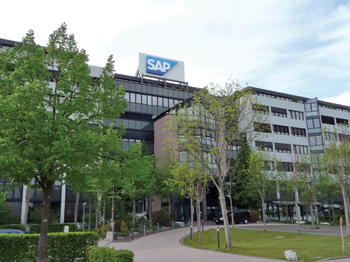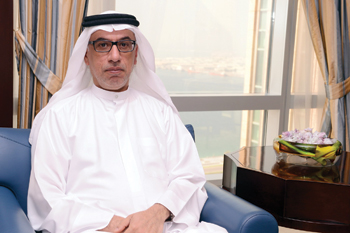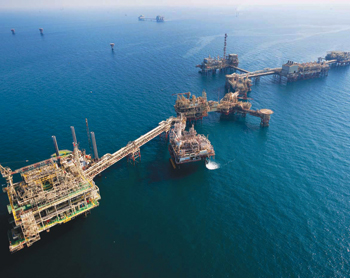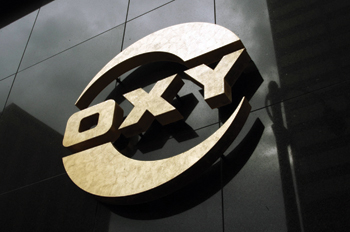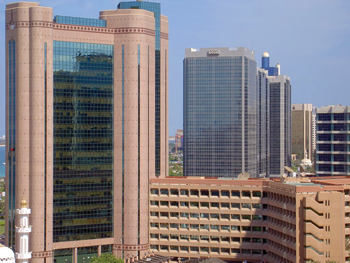
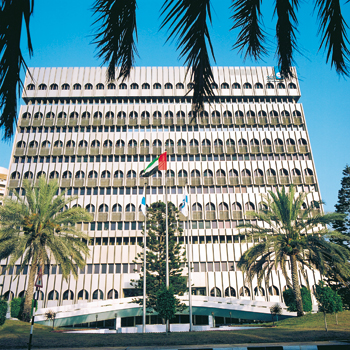 Adnoc ... seeing long-term goals
Adnoc ... seeing long-term goals
DESPITE plummeting oil prices, the UAE has pledged to increase oil production to 3.5 million barrels per day (mbpd) and also boost its refining capacity to 1.1 mbpd from the current levels of 707,000 bpd by 2017 in an ambitious $100-billion upstream and downstream investment programme over roughly a 10-year period. The UAE’s present oil production is around 2.8 mbpd.
Its onshore expansion to boost production from 1.4 mbpd to 1.8 mbpd will cost $22 billion, while the Adma-Opco field expansion from 620,000 bpd to 1 mbpd will come in at $31 billion, says Omar Suwaina Al Suwaidi, Adnoc deputy director for strategy and coordination.
Its downstream expansions, including a greenfield 417,000 bpd refinery, green diesel, base oils and carbon black project, will come in at $18 billion, he says.
The $10-billion Shah sour gas project will start up in December, and quickly rise to 1 billion cubic feet per day. Gas and petrochemical projects will add another $20 billion.
Much of the increase in production capacity will come from the refurbished Al Ruwais refinery, which doubled its capacity of 415,000 bpd by the end of 2014.
The proposed greenfield refinery will be built in Fujairah, on the UAE’s East coast. The new refinery is expected to increase the UAE’s refining capacity by a further 200,000 bpd when it is completed in 2017.
Abu Dhabi has begun early preparations for its next big oil auction, even as the heated competition for the 100 billion barrel onshore fields has not yet concluded.
The oil-rich emirate is planning to issue a tender to international oil companies (IOCs) for the 620,000 bpd offshore concession, which is operated by Abu Dhabi Marine Operating Co (Adma-Opco) until March 8, 2018. The concession includes four fields – Umm Shaif, Lower Zakum, Umm Lulu and Nasr – that will be expanded to produce just under 1 mbpd by 2020.
Adma-Opco is held 40 per cent by BP, Total and Japan’s Jodco. Abu Dhabi National Oil Co (Adnoc) holds the remaining stake.
Adnoc will be in charge of setting up the tendering process to put a new foreign partnership in place after the expiry date, which it has done after previous concessions lapsed.
“There are some preparations to get things underway to at least get the process ready,”, says.
Right now, Adnoc is working on the long-term vision for the offshore fields, with a heavy focus on future technical requirements, the official says. Abu Dhabi has committed to boosting the recovery rates of its oil fields – both onshore and offshore – to 70 per cent or more and wants partners that will bring enhanced oil recovery techniques. “There is a big emphasis on the technical side,” says Al Suwaidi.
 |
Al Mazroui ... the Shah project is on track |
He says that it is too early to say when the tender will be ready or when Adnoc would start negotiations with oil firms. “The exact timing is not set yet,” he says.
Adnoc will likely keep the same structure that it used to tender out the onshore concession, which expired last January. In June 2012, Adnoc, after enlisting the help of consultancy Mckinsey & Co., invited the world’s biggest oil firms to express interest in bidding for a 40-year stake in the 1.6 mbpd set of fields.
After narrowing the list, it sent invitations to bid to 11 firms in March 2013, asking them to submit comprehensive technical and commercial bids – in the form of a signing bonus – by October 22, 2013. Adnoc will own 60 per cent of the venture, and the collection of foreign partners will split the remaining 40 per cent.
Al Suwaidi says the process and structure for Adma-Opco is not fully defined, but Adnoc typically prefers to keep things the same. “Expect something similar,” he says.
The first steps on Adma come as the IOCs are eagerly awaiting word about the fate of their bids on the onshore fields – made more than a year ago. There was speculation that Abu Dhabi would announce the winners at Adipec, one of the largest oil events in the Mideast, but Adnoc officials have says nothing publicly about the tender process.
Adnoc is understood to have sent its recommendations to the Supreme Petroleum Council, the highest oil authority, which is not yet ready to publicly announce its decision, say multiple industry sources. Adnoc asked companies to extend the validity of their bids until December 31. Industry sources were hopeful, but not sure, that the process could be finished in the few weeks remaining.
Meanwhile, Adma-Opco began initial production from the offshore Umm Lulu oilfield in October. By 2018 this will add more than 100,000 bpd of crude to the UAE’s oil production capacity. Abu Dhabi boasts 100 billion barrels of proven oil reserves, accounting for 6 per cent of the world’s total.
However, with oil prices under pressure, having fallen by around 30 per cent since June 2014, and questions are being asked about the UAE’s oil production strategy. Senior officials acknowledge the difficulty of the situation, given substantial oversupply in the global market and diminishing call on Opec crude. Yet they are not willing to be rushed into decisions. Given its substantial fiscal reserves, the UAE can afford at the moment to be less hawkish than other more vulnerable Opec states such as Venezuela and Algeria.
Abu Dhabi’s challenge ultimately boils down to whether the authorities are looking to get better fiscal terms out of the Adco licence renewals, in which case the Asian NOCs are likely to be better placed, or whether they want the improved recovery rates that majors like BP, Total and Shell are offering.
BP’s chief executive, Bob Dudley, visiting the UAE for the annual Abu Dhabi International Petroleum Exhibition & Conference, said that an additional 1 per cent recovery from the reservoirs is worth some $200 billion of value to the country. Given these considerations a mixed portfolio of companies may be the most likely outcome.
Whatever the outcome of the bidding process and despite the recent fall in prices, Adco is still talking about increasing capacity. The aim is to raise output from Adco’s fields by 200,000 bpd to 1.8m bpd by 2017. Adco’s chief executive reiterated this aim in early November and estimated that this would require $5 billion-7 billion a year over the next three years.
The market oversupply globally suggests no immediate need for additional barrels. However, the UAE is thinking for the long-term and does not want to lose market share to Opec rivals like Iran. The country’s fiscal buffer helps it to make this calculation and the UAE is not likely to be bounced into any hasty decisions as regards its pivotal hydrocarbons sector.
 |
Adco ... awaiting licence renewals |
Meanwhile, Suhail Bin Mohammad Faraj Faris Al Mazroui, UAE’s Minister of Energy, says that Adnoc has so far invested $70 billion to develop new oil and gasfields and to boost the current output capacity of the UAE to 3.5 mbpd by 2017.
“The Shah Gas Project is on track to commence production ... The Abu Dhabi Company for Onshore Oil Operations (Adco) is set to augment its oil production capacity from the current 1.4 mbpd to 1.8 mbpd by 2017,” the minister says.
On how the UAE will meet the exponential demand for gas required by industry, water and electricity projects, Al Mazroui says the UAE was planning a raft of projects under its national strategy to diversify the energy mix as the liquefied natural gas (LNG) production is enough to meet 50 per cent of the local demand while the remaining 50 per cent was imported.
“We expect to develop new gasfields and launch new projects to import LNG. These projects include the awarding of a contract for the Emirates LNG project in Fujairah by the end of 2014 or early 2015.”
Developed by the Abu Dhabi-based companies Mubadala Petroleum (Mubadala), the project, the largest of its kind in the region, was designed on the concept of land-based re-gasification and storage terminal with a total capacity of 9 million tonnes per year (mtpy) of LNG. Speaking about the latest developments in the world oil market, the minister says the average oil prices that have been persisting over the past four years seemed balanced and suitable to both producers and consumers and could stimulate investment in output capacity in order to meet the growing demand.
About the threat that the shale oil could pose to conventional oil and gas industry, particularly to the Opec member states, the minister says, “We don’t see any potential threat of the shale oil usage as producers, given the high production cost of this fuel in comparison with that of the conventional oil. On the contrary, we think these new discoveries will help strike a balance in the supply-demand equation and in reaching a fair price in favour of producers.”
On the possibility of the UAE’s import of shale gas from the US to satisfy its gas thirst, the Minister of Energy says: “The UAE is considering import of gas from several LNG markets. However, we believe that our policy to diversify LNG import markets will continue. As the shale gas remains one of our promising supply options, it could constitute a proportion of our gas import bill in the future.”
Abu Dhabi is also preparing for increased competition in the global oil market from West Africa and Latin America in 2015, with a widening oversupply of more than 2 mbpd, a senior government official says.
Global oil demand is estimated at 91.19 mbpd in 2014 before rising 1.19 mbpd next year to 92.38 mbpd, according to Mubarak Al Ketbi, deputy director of marketing and refining at Adnoc. Asian oil demand growth will continue to increase, contributing about 33 per cent of total world demand, Ketbi says.
The traditional trade flow into Asia has witnessed diversification, particularly West African and Latin American crudes being moved to Asia due to lower US crude imports amid higher flows of Canadian heavy crudes into the US, Ketbi says.
Exports to the US, as high as 3.5 mbpd in 2005, are now down to less than 2.5 mbpd.
The displaced volumes are being moved into Asia. In 2013, Latin American crude exports to Asia totalled 1.1 mbpd, around 30 per cent of its total shipments. By 2030, this figure could be as high as 2 mbpd, 53 per cent of the total. Middle East crude oil will continue to be the main source of exports to Asia due to its geographic location, proximity to the market and crude quality. But Ketbi warns they will face a very competitive market as arbitrage crude flows from the West to East are rising.
Adnoc is also carefully watching developments in the US, which is debating lifting its 40-year-old ban on crude oil exports. In the near future, we may see the US start to lift the ban and export, Ketbi says. “It will definitely add more supply to the market, but let’s wait and see,” he says.
To compete in an increasingly diverse market, Abu Dhabi is focusing on its long-term relationships with Asian buyers, many of which date back to the 1970s. As such, Abu Dhabi will not be drawn into a price war, slashing prices to gain greater market share.
“We in Abu Dhabi set prices on a monthly basis,” Ketbi says. “There are lots of parameters – supply and demand, plus other elements like refinery margins. But we are long-termed oriented. We dont set the price for the short term.”
Earlier last year, Abu Dhabi opened up around 200,000 bpd of crude oil to be freely traded, for the first time in its history as an exporter.
The response from buyers was positive, Ketbi says, as it gave greater flexibility. More volume could be traded in the future as Adnoc plans to reassess its long-term contracts to serve its own targets and its customers’ needs.
Adnoc is a vertically integrated national oil group. The group participates in all the aspects of oil and gas value chain right from exploration and production to marketing and distribution. Its operations include exploration and production (E&P), support services, oil refining and gas processing.











































































